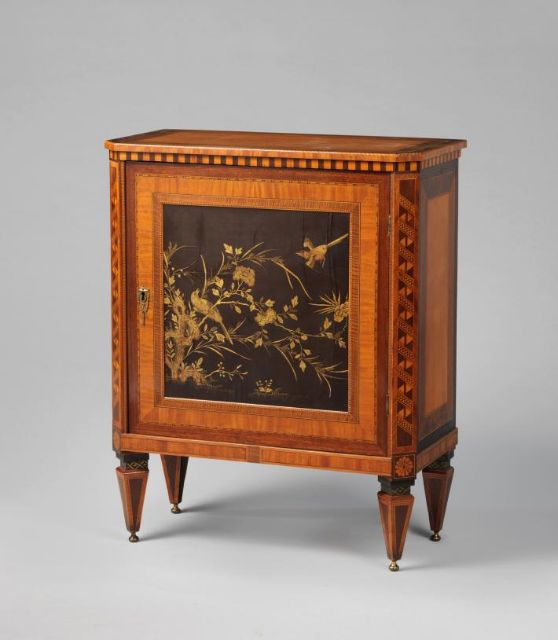A hype for orientalism

Fig. 6: Anonymous, cabinet with door with lacquer panel, gold lacquer on black ground, with birds, flowers and plants, Northern Netherlands, 1780, wood (plant material)oak (wood)satinwood (wood)purpleheart (wood)maple (wood)lacquer (coating), 81.5× 66 × 32.5cm (h,w,d) 16.8 kg, Rijksmuseum, Amsterdam, inv.nr. BK-1961-19, De Bruijn-van der Leeuw Bequest, Muri, Switzerland, http://hdl.handle.net/10934/RM0001.COLLECT.293536
Trading companies like the VOC (Dutch East India Company) played an important role in shipping cargo filled with ‘all things Eastern’ via the famous Silk Road. Items such as spices, cotton, sugar, gold, silk, tea, lacquer and porcelain were brought to Holland. These activities led to the prevalence of Asian objects in Dutch interiors. These objects ranged from small utility items to larger pieces of furniture, such as this cabinet with incorporated Japanese lacquer panels [fig.6]. Owning and displaying these objects directly indicated taste, domestic wealth and high levels of sophistication. Besides demonstrating the status of their owner, they also served as a means to augment their surroundings.
New fashions inspired a new consumer taste. As a consequence, both import and domestic production grew. The oriental aesthetic became favorable, and European demand was on the rise. There was a strong fascination with the ‘other’, particularly concerning material culture, where the West conceptually thought of the East (‘the Orient’) as the source for new ideas and products.
European imitation of ‘oriental’ objects can be explained by way of different phases of which two will be relevant to this story. The first is that of the duplicate: the aim to replicate and convince the customer that it is the real deal even though it is merely an attempt to produce something that comes close to the original. Second, there is the copying of distinct aspects of the original, which would serve as a model for decorative elements, style or shape.